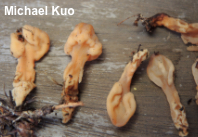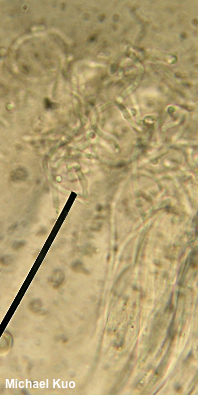| Major Groups > Clubs & Corals / Oddballs & Misfits > Spathularia flavida var. ramosa |

|
Spathularia flavida var. ramosa [ Ascomycota > Rhytismatales > Cudoniaceae > Spathularia ... ] by Michael Kuo Found in the Rocky Mountains, this interesting mushroom is currently passing as Spathularia flavida, but it is pretty clearly distinct from both the originally named European version of that species and some North American versions, which feature a pale yellow to white stem and a clear yellow, usually-flattened head—as opposed to the brownish orange to orangish stem and the dull orangish, usually three-dimensional head of the Rocky Mountain version. In 1955 Mains named Spathularia flavida var. ramosa, designating a collection made in Idaho by Smith and Bigelow as the type collection; Mains said the variety differed from the typical variety in its paraphyses, which were "much branched above," and in the shape of the fruiting bodies, which "show considerable variation from typical spathulate to a clavate, slightly flattened condition." Bigelow's notes in the collection box describe a "clavate, pale pinkish buff" head and provide an identification of "Microglossum?"; the suggestion of Microglossum over Spathularia further supports the idea that the mushroom in question is often three-dimensionally club-shaped. While mycologists since Mains have tended to collapse var. ramosa into synonymy with a broadly-conceived Spathularia flavida, I have resurrected the name here to point out substantial differences in morphology; I suspect that a separate species should be named for the Rocky Mountain entity. Description: Ecology: Presumably saprobic; growing gregariously or in clusters under conifers in needle duff; late summer; Rocky Mountains. The illustrated and described collection is from Colorado. Fruiting Body: Roughly club-shaped, with an irregular, sometimes-flattened head portion at the top of a stem. Head 10–30 mm across; 10–30 mm high; irregular in shape but usually more or less club-shaped, varying to somewhat flattened; dull orangish; bald and often slightly wrinkled; moist when fresh. Stem 10–20 x 2–5 mm; more or less equal; bald; dull orangish to orangish brown; becoming hollow; attached to whitish mycelium. Flesh insubstantial; orangish. Odor not distinctive. Microscopic Features: Spores 65–80 x 1–2 µm; aciculate; often slightly curved; smooth; hyaline and multiguttulate in KOH. Asci 120–130 x 12–14 µm; fusiform; hyaline in KOH. Paraphyses 120–150 x 1–2 µm; cylindric; septate; often branching; flexuous; apices rounded or subclavate; often curving, hooking, or curling past the asci; smooth; hyaline in KOH. REFERENCES: Mains, 1955. (Cripps, Evenson & Kuo, 2016.) Herb. Kuo 08141505. This site contains no information about the edibility or toxicity of mushrooms. |
© MushroomExpert.Com |
|
Cite this page as: Kuo, M. (2019, April). Spathularia flavida var. ramosa. Retrieved from the MushroomExpert.Com Web site: http://www.mushroomexpert.com/spathularia_flavida_ramosa.html |





